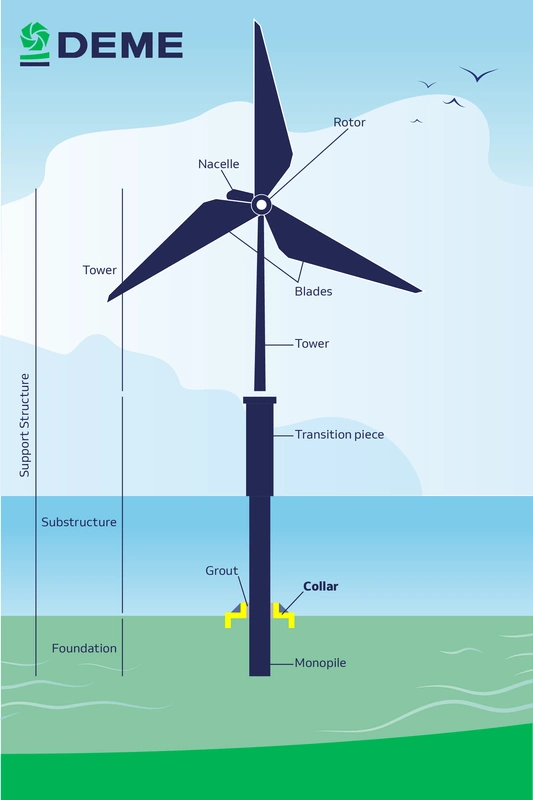
Renewable energy company RWE will deploy special collars around the monopile foundations at the seabed level at its Kaskasi offshore wind farm, in what has been described as "the first time ever in the renewables industry."
The ‘collared monopile’ is designed based on an RWE patent. The new technology will provide additional support for lateral loading, increase the bearing capacity and improve the structural integrity of the entire foundation – especially in difficult ground.
RWE Renewables has signed a contract with DEME Offshore for the transport and installation of the new foundation technology at RWE’s 342-MW Kaskasi offshore wind farm, located in the German North Sea, 35 kilometers north of the island of Heligoland.
Sven Utermöhlen, Chief Operating Officer Wind Offshore Global at RWE Renewables, says:
“At our Kaskasi offshore wind farm we use innovative technologies that will set standards throughout the offshore industry. The collared monopile, a patented solution developed in-house, will help to increase stability in difficult ground. Furthermore, Kaskasi will be the first commercial offshore wind farm in the world to use an improved installation method to drive all monopile foundations to target penetration. The vibro pile driving technique will reduce both installation time as well as noise emissions for marine life."
(The article continues below the image) Credit: DEME
Credit: DEME
The Kaskasi offshore wind farm will consist of a total of 38 wind turbines. Each turbine will have a capacity of up to 9 MW. The wind turbines will be installed on monopile foundations. The installation of the foundations will start in the third quarter of 2021. RWE will use the “vibro pile driving” installation method, which has been described as an efficient alternative to the conventional method of hammering monopiles into the seabed.
This installation method could reduce installation time and noise emissions during construction. Kaskasi will be the first commercial offshore wind farm in the world using the vibro driving technique to install all monopile foundations to target penetration.
Collared monopiles
When target penetration is reached, the foundation collars will be deployed at three locations. The detailed design was developed by the German civil engineering company JBO based on the RWE patent.
Bladt Industries was selected as the manufacturer. DEME Offshore will transport the three collars from the manufacturer’s load-out port in Aalborg, Denmark, to the Kaskasi construction site near Heligoland. Then the DEME Offshore team will install the steel collars around three of the 38 monopile foundations for which DEME Offshore will deploy the jack-up vessel ‘Neptune.’
The collar will be installed at seabed level in water depths of up to 25 meters. The space between the collar and monopile foundation will be filled with grout material to create a stable connection. RWE will carry out accompanying tests to verify that the collar improves the structural behavior in comparison to standard monopiles.
It is expected that the Kaskasi wind farm will start commercial operations in summer 2022. Once all wind turbines are fully operational, the wind farm will supply the equivalent of more than 400,000 homes with electricity.


